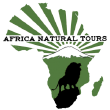
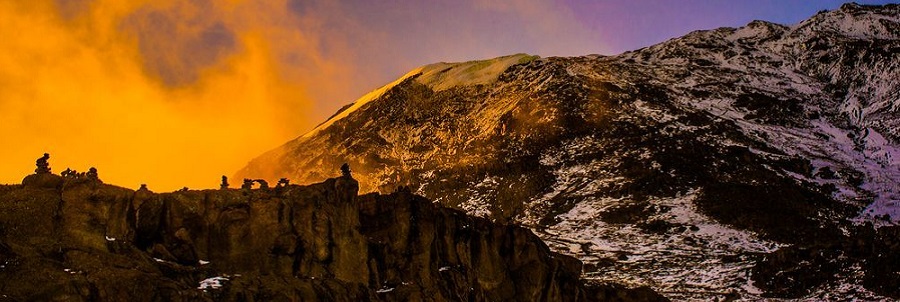
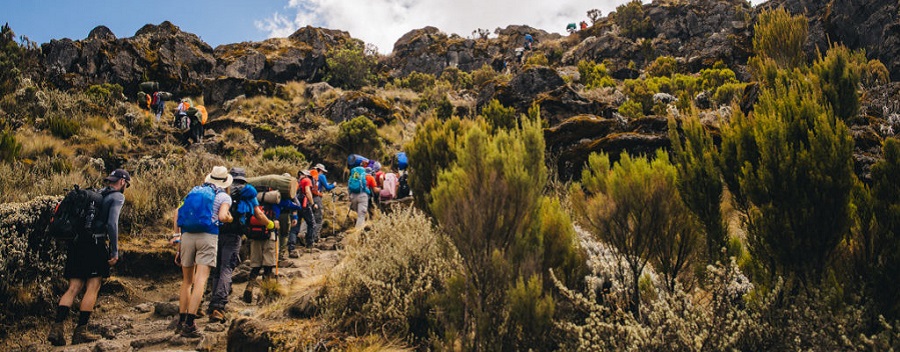
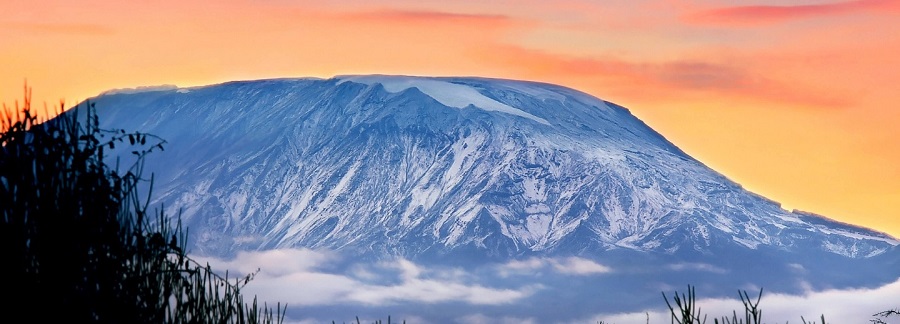
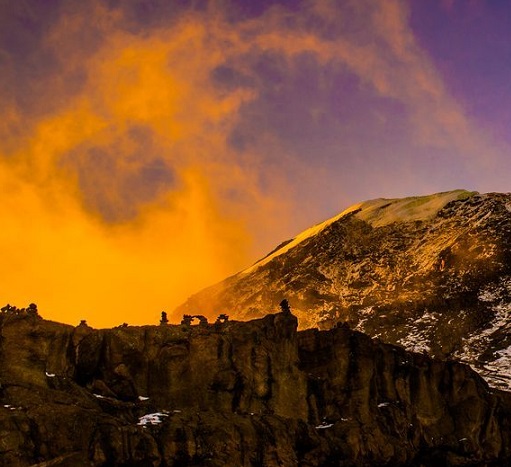
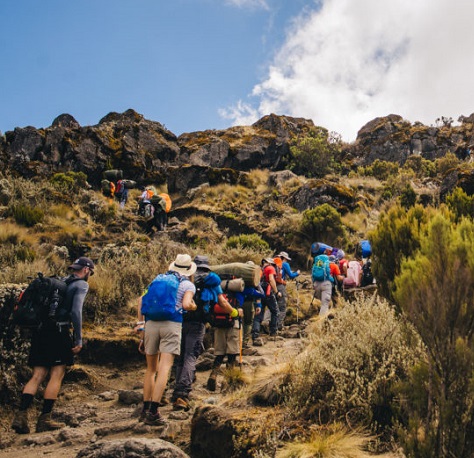
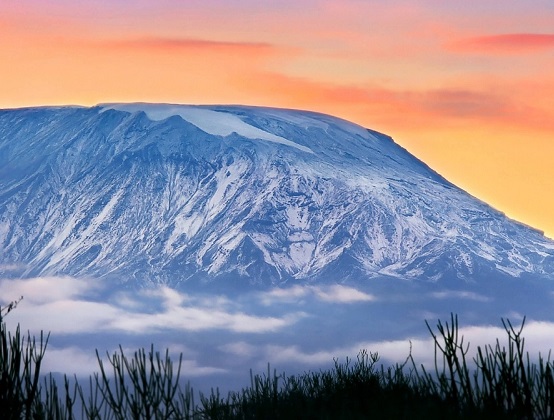
Gewaagde ervaren klimmers die op zoek zijn naar avontuur en uitdaging zullen op Umbwe precies vinden wat ze willen. Een korte steile klim door alle klimaatzones - van tropisch regenwoud tot eeuwig ijs - zal je kracht en uithoudingsvermogen op de proef stellen. Als geen andere route op de Kilimanjaro geeft Umbwe een gevoel van voldoening aan degenen die de top bereiken.
Je eerste dag op de berg begint bij Umbwe Gate en gaat verder met een lange tocht naar het eerste kamp onderweg - Umbwe-kamp. Ondanks de uitdaging die Umbwe stelt aan wandelaars, zal een goed doordachte locatie van kampen bijdragen aan een goede acclimatisatie.
De trektocht door Umbwe is alleen beschikbaar als een 7-daags programma. Alleen aanbevolen voor ervaren wandelaars in goede fysieke conditie.
Na een vroeg ontbijt krijgt u een briefing van uw gids. Om 9.00 uur nemen onze medewerkers u mee op een rit van een uur van uw hotel in Moshi naar het Umbwe Village, waar uw gidsen en dragers uw uitrusting en benodigdheden zullen voorbereiden. De registratie van Kilimanjaro Park wordt hier voltooid en u ontvangt ook uw lunchpakket. Na registratie begint u uw beklimming vanaf de Umbwe Gate en gaat u verder op een klein voertuigpad totdat u de bewegwijzering bereikt die aangeeft dat u de Umbwe Trail hebt bereikt. Je klimt dan 5-6 uur door dicht regenwoud. Het is onmogelijk om de gigantische vijgenbomen en rubberbomen te missen, omdat op sommige plaatsen hun wortels het pad hebben ingehaald. Hoewel ze zelf soms ook glad zijn, kunnen ze goede voet aan de grond krijgen als het pad na een regenbui slordig wordt met modder. Umbwe Camp ligt in het bos en is uw eerste stop. Wanneer je aankomt, zul je merken dat je kamp en tent al zijn opgezet door de dragers die voorop liepen. Zij brengen u gekookt drinkwater en waswater ter voorbereiding van het diner.
Vroeg opstaan voor koffie of thee. Na het ontbijt inpakken voor de trektocht van de dag. Je tocht begint steil door de verdwijnende open plekken in het regenwoud voordat je opstijgt naar de drogere lucht van Giant Erica en Heathland-terrein waar de vegetatie schaars is met kleine struiken. Je gaat verder op een onbedekte bergkam die je je eerste uitzicht op Uhuru Peak biedt als de wolken voldoende zijn verdwenen. Na de lunch begin je het semi-woestijngebied te betreden wanneer je door een tuin met Senecio-planten trekt. Deze vreemd uitziende kruimels lijken op een prehistorische cactus. Zodra u Barranco Camp bereikt, zullen uw dragers drink- en waswater koken voordat ze het diner serveren. Terwijl u wacht op uw diner, krijgt u de kans om een van de meest gedenkwaardige zonsondergangen te ervaren die u ooit hebt gezien terwijl de zon door de vallei zakt. Let goed op je lichaam en houd je gids op de hoogte van eventuele tekenen van hoogteziekte.
Acclimatisatie Je brengt dag 3 door in de buurt van Barranco Camp voor de broodnodige acclimatisatie. Houd uw camera bij de hand om het landschap van de met tuinkruiden begroeide camping vast te leggen. Veel trekkers beschouwen dit als hun favoriete kamp op dit parcours, wat nog een reden is dat dit de perfecte plek is voor je acclimatisatiedag. Als u er zeker van bent dat uw lichaam goed kan acclimatiseren, kunt u de 6-daagse Umbwe-route kiezen.
Nadat je onder de Great Barranco Wall hebt geslapen, krijg je de kans om deze hindernis te nemen. Maak je geen zorgen... Het is veel gemakkelijker dan het lijkt. Ga verder omhoog tot je net onder de Heim-gletsjer komt. Ga vervolgens naar beneden door de Karanga-vallei. Dit is de laatste plaats voor uw dragers om water te verzamelen. Hier verzamelen ze al het water voor de rest van de klim. Je vestigt je hier in het Karanga Camp. Na de lunch kun je de middag doorbrengen met licht verkennen of uitrusten terwijl je geniet van het uitzicht op de torenhoge torenspitsen van Mawenzi.
Na het ontbijt ga je naar het oosten, waarbij je meerdere bergkammen en valleien oversteekt tot je uitkomt op de Mweka-route en linksaf slaat om een uur lang de bergkam op te gaan om de Barafu-hut te bereiken. Je komt aan bij het kamp waar je tent staat op een rotsachtige bergkam met harde wind. Zorg ervoor dat u zich voor het donker vertrouwd maakt met het kamp om veilig te zijn. Houd ook uw hoofdlamp/zaklamp bij de hand als u de tent in het donker moet verlaten. Je bereidt je uitrusting voor (vervang batterijen voor koplamp en camera) voordat je om 19.00 uur naar bed gaat en probeert een paar uur shuteye te vangen voor je toppoging!
Word wakker om 23.30 uur voor thee of koffie en koekjes en vertrek vervolgens uit Barafu op uw bod voor de piek. Je klimt 6 uur door dikke puinhellingen na meerdere haarspeldbochten tussen de Ratzel- en Rebmann-gletsjers tot je Stella Point (18.650 ft/5.685 m) bereikt. Je hebt zojuist voltooid wat de meeste klimmers als het meest uitdagende deel van hun trektocht beschouwen. Afhankelijk van je tempo tot nu toe, kun je hier tijdens je korte rustpauze genieten van de majestueuze zonsopgang. Hoewel je vermoeid zult zijn, is het vanwege de extreme kou belangrijk om te blijven bewegen. Bij Stella Point kom je aan bij het laatste stukje van de Marangu Route. Je wandelt nog 1-2 uur langs de rand totdat je je uiteindelijke doel van Uhuru Peak bereikt. Gefeliciteerd, je staat nu op het Dak van Afrika! Je hebt tijd om foto's te maken met het wereldberoemde Uhuru Peak-bord, maar het is belangrijk om snel aan je afdaling te beginnen om voldoende tijd te hebben om uit te rusten in het Barafu Camp. Na een afdaling van 3 uur over een glijdende puinhelling, bereik je Barafu om even uit te rusten terwijl je je uitrusting ophaalt en vervolgt je het pad terug naar het boskamp van Mweka. In de middag kunt u een beetje regen krijgen, dus zorg ervoor dat u uw regenkleding in uw dagrugzak hebt. Geniet van een diner en een welverdiende nachtrust. Bij Mweka Camp verkoopt het kantoor flessenwater, frisdranken, candybars en bier.
Word zoals gewoonlijk wakker voor het ontbijt, pak in en daal af via een korte, schilderachtige wandeling van 3 uur naar Mweka Gate. Wacht tot jij en al je spullen de poort hebben bereikt voordat je je personeel een fooi geeft. Nadat je je bij de gate hebt geregistreerd, wacht je op het ontvangen van je topcertificaten (groen voor degenen die Stella Point hebben bereikt en goud voor degenen die Uhuru Peak bereiken). Vanaf de poort, als de weg te modderig is voor voertuigen, vervolgt u uw wandeling gedurende 1 uur naar het Mweka-dorp, op 3 km afstand. Daar geniet je van een warme lunch voordat je wordt teruggebracht naar Moshi, waar je je eerste warme douche in dagen kunt nemen! Dag van vertrek: Transfer naar de Kilimanjaro Airport.

o Parkkosten,
o Parkkosten,
o Kampeergelden
o 18% btw op tourkosten en diensten die bijna 55% van de totale in rekening gebrachte kosten kosten.
o Vervoer van en naar de bergpoort
o Professionele berggidsen, koks en dragers
o 3 maaltijden per dag op de berg
o Gefilterd water tijdens de trek
o Eerlijk loon voor de bergbemanning zoals goedgekeurd door de Kilimanjaro National Park Authority (KINAPA), Kilimanjaro Association of Tour Operators (KIATO)
During the climb your accommodation will be camping.
o Medische verzekering
o Visumkosten die $ 50 zijn, behalve voor Canadese en Amerikaanse paspoorthouders, die $ 100 zijn
o Tips voor bergbemanning
o Zaken van persoonlijke aard
o Wasservice
o Een dokter voor de groep
o Draagbaar toilet met toilettent is extra ($ 150 per toilet + toilettent)
This route takes 6 days to complete the climb although 7 days is recommended as Umbwe is the most difficult route of all. Ideally this route is for those who are up for a challenge and are physically fit due to the of steepness of the route. It is also the least crowded route.
With reference to the quote, we shall be providing you with all your camping equipment, along with tents and sleeping mats. What are not included are sleeping bags (although these can be hired), water canteens, flashlights and clothing. Provided below is a list of suggestions.
Prior to departure, you will need to pack the bulk of your clothing and gear into a large rucksack or duffel bag which will be carried by the crew. Note, no bag on Kilimanjaro (irrespective of who carries it) should weigh more than 15 kg and will be weighed at the gate). Clients will carry a smaller backpack or day-pack with key items of clothing and personal effects.
After a hearty breakfast your guide will come to collect you from Honey Badger Lodge and you will drive to Umbwe gate. After completing the gate registration procedures, the trek starts through the rainforest. There is a strong possibility of rain in the forest, which will transform the trail into a very soggy, muddy and slippery experience. You will have a welcome packed lunch stop about half way and you will continue walking until you reach Umbwe cave camp area in the late afternoon. The crew will set everything out at your campsite and all you have to do is sit back, relax and enjoy the great outdoors.
On Day two the landscape changes rapidly from rainforest to moorland, with rocky outcrops and sparse vegetation. The path follows the narrow Umbwe Route ridge until it begins to flatten close to the Barranco Valley. The Barranco Camp (3,950 m) sits in the valley under the shadow of the Great Barranco wall with Kibo visible in the distance. You will notice the camp is pretty busy. This is because you will be joining hikers from the Machame, Lemosho and Shira Route. When reaching the camp the crew will provide you with a tasty meal and you will then have plenty of time to sit back and relax.
Today you will be having a short day walk and in the late morning you will start climbing Barranco wall and reach 4,200 m for acclimatisation and continue crossing ridges and valleys to Karanga Campsite for hot lunch. After a delicious lunch you will have a short rest and another acclimatisation of trekking up the screed slopes toward the Southern ice field then you will return to the camp for dinner and overnight stay. On the way our experienced team will coach you through the symptoms and provide you with all the advice and support you need.
Your day begins by trek up to the Barafu ridge. It will be little tough because of the altitude. On this day the walking hours will be few because the path is steep hence needs slow walk in order to avoid fatigue as well as high altitude sickness. You will walk across the alpine desert with strong and cold wind blowing because there is no trees around as well as getting closer to the Kibo glaciers. On this day you will have an early dinner of around 17.00 h then try to get some precious rest and sleep until midnight when you push for the summit.
At about 23:30h you will be awoken to some tea and biscuits and will make a move into the night. You will head in a north-westerly direction and ascend through heavy scree towards Stella Point on the crater rim. Many climbers find this 6-hour walk to Stella point the most mentally and physically challenging aspect of the climb. At Stella Point (5,685 m) your efforts will be rewarded with a short rest and the most magnificent sunrise you are ever likely to see (weather permitting). From Stella Point you will normally encounter snow all the way on your 2-hour ascent to Uhuru Peak, the highest point in Africa and achievement you will remember for the rest of your life. The walk back to Barafu from the summit, takes about 3 hours. Here you will have a well-earned but short rest and collect the rest of your gear, before heading down to Mweka camp (3,100 m). The route is not difficult and will take you down the rock and scree path into the moorland and eventually into the forest. Here you will rest and feel proud of your achievement.
After an early and well-deserved breakfast, it is a short 3-hour and scenic hike back to the Park gate where you will receive your certificates; those climbers who reached Stella Point (5,685 m) are issued with green certificates and those who reached Uhuru Peak (5,895 m) receive gold certificates. You will be picked up and brought back to the lodge for a warm welcome, a cold celebratory drink and a hearty meal.
mount kilimanjaro from Nairobi Kenya, mount kilimanjaro from Kampara Uganda, mount kilimanjaro from Kigari Rwanda,
mount kilimanjaro gears, mount kilimanjaro camps, mount kilimanjaro records, mount kilimanjaro clothes, mount kilimanjaro base camp
mount kilimanjaro climbing companies, mount kilimanjaro informations, mount kilimanjaro vegetations and frowers
mount kilimanjaro hiking company, mount kilimanjaro hiking operator, mount kilimanjaro hiking operators,
mount kilimanjaro hiking agency, mount kilimanjaro hiking, mount kilimanjaro internet, mount kilimanjaro electricity
mount kilimanjaro hiking agences, mount kilimanjaro climbing adventures, mount kilimanjaro hiking adventure,
mount kilimanjaro hiking holiday, mount kilimanjaro hiking, mount kilimanjaro wanders, mount kilimanjaro to ngorongoro-crater
mount kilimanjaro hiking holidays, mount kilimanjaro hiking expeditions, mount kilimanjaro dangerous, mount kilimanjaro song
mount kilimanjaro ultimate, mount kilimanjaro ten interesting facts about, mount kilimanjaro Tanzania, mount kilimanjaro meaning
mount kilimanjaro the ultimate guide to Africa highest mountain, mount kilimanjaro formation, mount kilimanjaro travel
mount kilimanjaro hiking expedition, mount kilimanjaro climbing organizer, mount kilimanjaro local guide,
mount kilimanjaro acclimatizatiom, mount kilimanjaro creter, mount kilimanjaro national park tourism, mount kili
72 kilometres
Distance: The Rongai route is 72 kilometres (44 miles) long. Location: The Rongai route ascends Kilimanjaro from the northeastern side of the mountain, along the border between Tanzania and Kenya.
Northern Circuit Route
Northern Circuit Route has the highest Kilimanjaro Success Rate which is 95% and approaches from south of Kilimanjaro. It is the newest and longest route which offers the most spectacular view of overall 360-degree scenery of Mount Kilimanjaro. Climbing Mount Kilimanjaro on this route takes 8 to 9 days for the summit.
72 kilometres
Marangu route distance
Distance: The Marangu route is 72 kilometres (45 miles). Location: The route approaches Mount Kilimanjaro from the southeast. The trail itself starts at Marangu gate. Height: The route reaches the summit of Kilimanjaro at the Uhuru peak reaching a height of 5,895 metres (19,341 feet
approximately 62 kilometers The total Machame route distance is approximately 62 kilometers from gate to gate. One can complete the Machame route on a 6 or 7 day itinerary. Both options include a climb high, sleep low acclimatisation day.
The Machame Route: the most popular climbing route up Kilimanjaro. The Rongai Route: the easiest route on Kilimanjaro. The Shira Route: this one catapults you to some serious altitude on the first day. The Lemosho Route: hands down the most beautiful Kilimanjaro climb route, but expensive.
Climbing Kilimanjaro is probably one of the most dangerous things you will ever do. Every year, approximately 1,000 people are evacuated from the mountain, and approximately 10 deaths are reported. The actual number of deaths is believed to be two to three times higher.
The Machame Route is approximately 62 km/ 37 miles from gate to gate. It is designed for physically fit people with some hiking experience, but plenty of first time trekker use the route as well and do just fine. It is rated as one of Kilimanjaro's better routes and thus is recommended. 37 miles
We generally advise that the best time toclimb Kilimanjaro is during the warmest and driest times of year, from December to mid-March and mid-June to the end of October. However, although these are considered to be the best times to climb the mountain in terms of weather, they are also the busiest months.
Kilimanjaro is an achievement many hikers, athletes, and nature lovers have set their eyes on. But towering 19,341 feet, with a nearly 50% fail rate, reaching the peak takes a hefty amount of work against significant odds. Climbing Mt. Kilimanjaro is absolutely worth it.
How much does it cost to climb Kilimanjaro? the average trek price is $2000 to $4000 with many variables, read on for some prices. Climbing Mount Kilimanjaro is an expensive venture.
between 45% and 65%
Overall summit rates on Kilimanjaro (across all routes & climbers) are estimated to fall between 45% and 65%. Summit success rates by climbing duration - don't try to do Kilimanjaro on an itinerary that is shorter than a week or you'll set yourself up for failure.
Firstly, in our opinion, the summit day on Kilimanjaro is harder than anything you will encounter on the Everest Base Camp Trek. However, the days on Everest Base Camp treks are longer. Also, the day to day trekking is a bit tougher than on Kilimanjaro.
At the summit, Uhuru Point, the night time temperatures can range between 20 and -20 degrees Fahrenheit (-7 to -29 degrees Celsius). Due to Mount Kilimanjaro's great height, the mountain creates it's own weather.
Rongai route
The Rongai route is the easiest route up Kilimanjaro. It has a reputation as a remote wilderness trail. Rongai is the only route to approach Kilimanjaro from the north.
As we mentioned before, Kilimanjaro is suitable for beginners; they do very well. The best advice is for everyone to arrive in great shape. Don't underestimate the climb because you know someone did it who you believe was not fit. Train for the adventure.
You don't need to be exceptionally fit, but you do need to get your body used to the particular demands of this hike. Otherwise the first days will be so tiring that you will have no energy left when it counts. So, the best Kilimanjaro training is to simply walk.
Read our approach to summit night on Kilimanjaro is hard 1,245m/ 4,084ft of ascent at high into extreme altitude above 5,500m/ 18,000ft. It can take up to 7 hours to reach the summit. We like to set up camp in Kosovo Camp.
Ideally, you should try to hike as much as possible on hills or mountains to simulate climbing Mount Kilimanjaro. Doing day hikes is superb training. For those who do not have access to trails, the next best option is to train on stairs. You can also train very productively on a stair master machine.
Unfortunately it is not possible to climb Kilimanjaro without a guide. In 1991 the Tanzanian government and Kilimanjaro National Park Authority changed it's policy towards unsupported treks on Mount Kilimanjaro. In short the regulations require that all trekkers are accompanied by a registered and licensed guide.
257 m
How high is the Barranco Wall? The Barranco Wall Kilimanjaro is just 257 m from base to top. Many people think of it as being more than that
A detailed analysis of six cores retrieved from the rapidly shrinking ice fields atop Tanzania's Mount Kilimanjaro shows that those tropical glaciers began to form about 11,700 years ago. The cores also yielded remarkable evidence of three catastrophic droughts that plagued the tropics 8,300, 5,200 and 4,000 years ago
Have there been deaths on Mount Kilimanjaro? Approximately 30,000 people attempt to Climb Mount Kilimanjaro every year and on average the reported number of deaths is about 10 fatalities per year.
128,263 Steps Climbing Kilimanjaro, the Roof of Africa, in 128,263 Steps...
You do not need supplemental oxygen to climb Kilimanjaro. Supplementary oxygen is normally only used at extreme altitudes above 23,000 feet. Heights greater than 26,000 feet are inhospitable for sustained human life.
Snow on Kilimanjaro can occur all year round, but the most common months are November through March.
The 'Seven Summits' are comprised of the highest mountains on each of the seven continents of the Earth: Everest, Aconcagua, Denali, Kilimanjaro, Elbrus, Mount Vinson and Carstensz Pyramid.
Mount Kilimanjaro
Last eruption Between 150,000 and 200,000 years ago
Climbing
First ascent (European) 6 October 1889 by Hans Meyer and Ludwig Purtscheller
Easiest route Hiking
The short answer to the question: Can anyone climb Mount Kilimanjaro? is obviously no. ... You don't need to be particularly fit (indeed being too fit can be detrimental) and you do not need any technical climbing skills
The reason it is so expensive is because of the fees the government charges for you to climb the mountain. Mt. Kilimanjaro is a national park, and the Tanzanian government charges very high fees for you to visit it. ... The vast majority of the $1000 or so you have to pay goes to the government of Tanzania.
1. Acclimatise prior to the climb. ...
2. Start the climb in the best possible health and with an excellent level of physical fitness.
3. Take it easy on the trail and in camp. ... <
4. Drink plenty of fluids. ...
5. Eat well. ...
6. Sleep well. ...
7. Relax.
Most days climbing Kilimanjaro are no worse than an average day hiking at home. There are though a number of factors that make this a really tough challenge. First, you will be hiking for at least 7 days continuously. This puts a big strain on all your muscles and joints.
Stella Point is one of three summit points on Mount Kilimanjaro, next to Gilman's Point and the actual summit – Uhuru Peak.
Where do you sleep when you climb Kilimanjaro? When you trek Mt Kilimanjaro, you sleep in one of two places: in a mountain hut or a tent. Most trekkers sleep in tented camps, as only the Marangu route offers hut accommodation.
Mount Kilimanjaro is the tallest mountain on the African continent and the highest free-standing mountain in the world. ... Kilimanjaro has three volcanic cones, Mawenzi, Shira and Kibo. Mawenzi and Shira are extinct but Kibo, the highest peak, is dormant and could erupt again
The best route to climb Mount Kilimanjaro is the Lemosho Route. In our opinion the Lemosho route is the most scenic route on the mountain and the route that has the best acclimatization for a safe, enjoyable and successful ascent of Kilimanjaro.
16,732 feet Kilimanjaro lies within the 292-square-mile (756 square kilometers) Kilimanjaro National Park. Kilimanjaro rises from its base approximately 16,732 feet (5,100 meters) from the plains near the Tanzanian municipality of Moshi, making it the tallest free-standing mountain in the world.
You can drive up a section of Mt. Kilimanjaro but you can't get to the summit of the mountain using a vehicle. The closest you can get to the top of Kilimanjaro using a vehicle is by taking the Shira route which will drive you up the slopes of Kilimanjaro to 11,000 ft.The Rongai Route is the only route that appraoches Kilimanjaro from the north, near the Kenyan border. Rongai’s ascent profile is very similar to that of Marangu. It is one of Kilimanjaro’s easier routes. The climb to the top is gradual and steady. However, unlike Marangu, this route has low crowds and passes through remote wilderness areas. It is probably the only route where seeing wildlife in the first days is possible.
he route takes six days minimum to complete, although seven days is recommended. The descent is down Mweka, on the south-east side of the mountain. Because the starting point is far from Moshi, it is more expensive to climb this route due to the added transportation cost of getting climbers to the gate.
Scenically, Rongai is beautiful because it travels through an unspoiled rain forest and remote wilderness area. However, it is not as scenically varied as Machame, Lemosho and Shira.
Rongai is ideal for those who are not confident in their ability to hike over steeper paths, those who want to avoid traffic, and those who want to enjoy a quieter hike. It is also preferred when climbing during the rainy season because the north side of the mountain receives less precipitation.